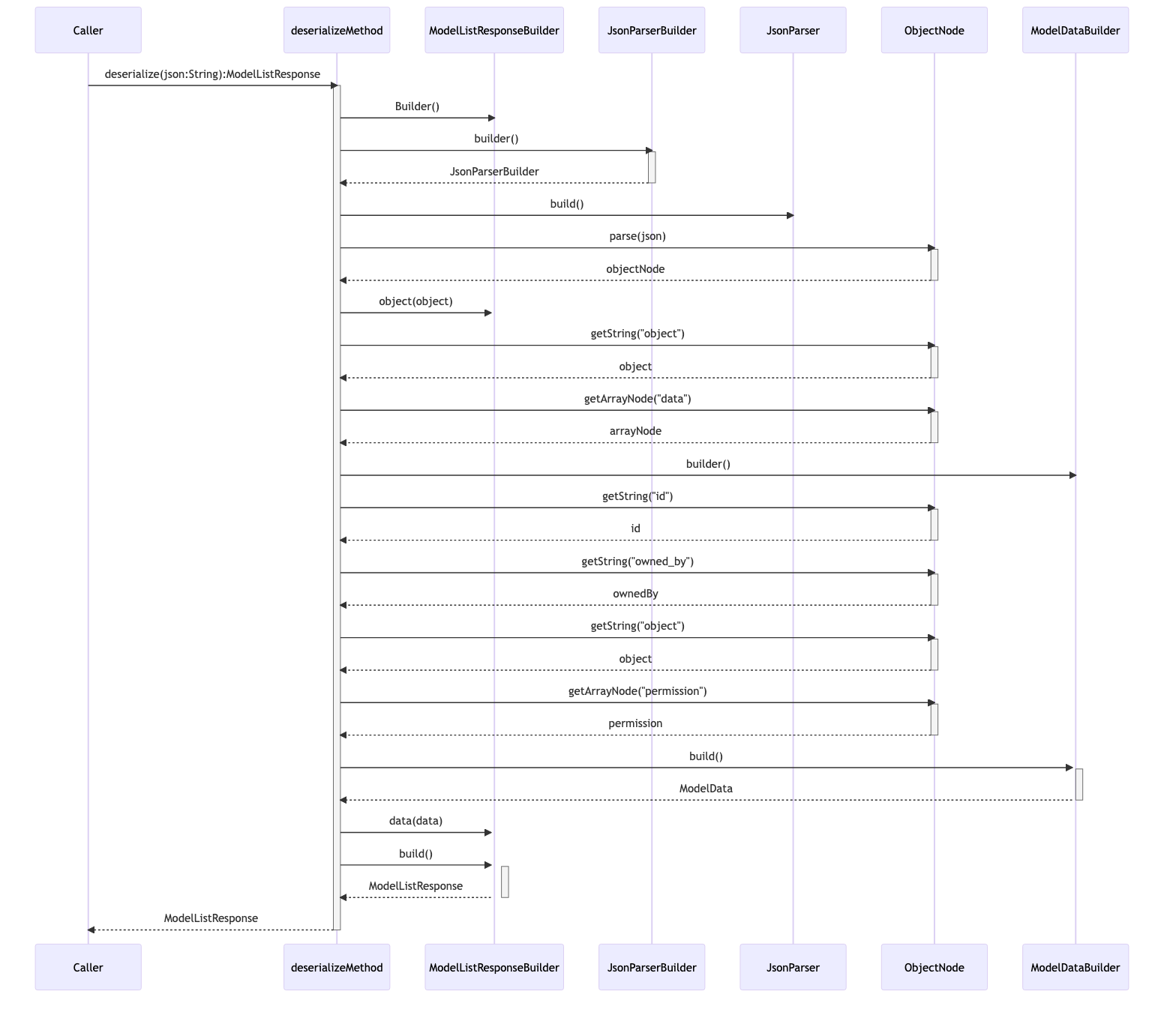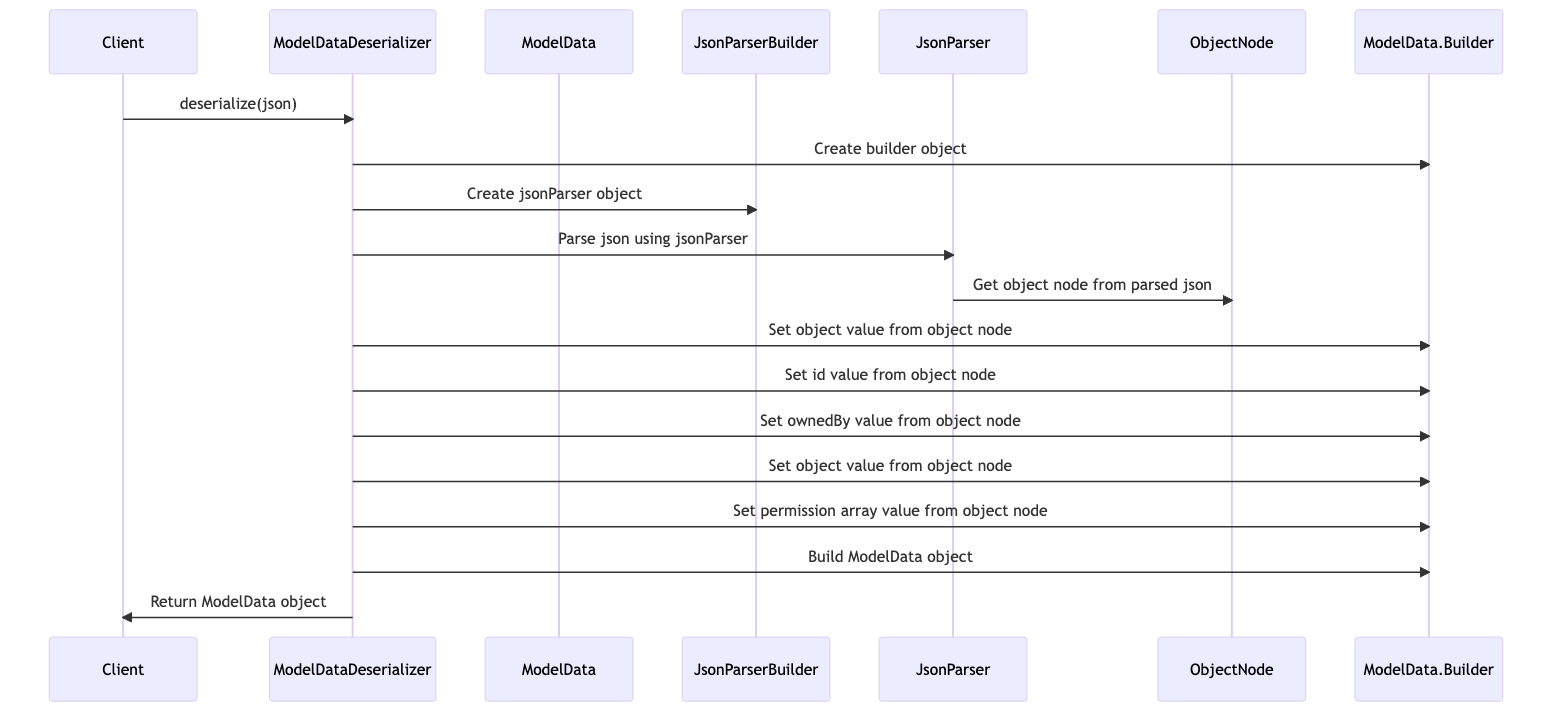-
Notifications
You must be signed in to change notification settings - Fork 2
com_cloudurable_jai_model_model

The ModelListResponseDeserializer class provides methods to deserialize a JSON string into a ModelListResponse object.
public static ModelListResponse deserialize(final String json) {
final ModelListResponse.Builder builder = ModelListResponse.builder();
final JsonParser jsonParser = JsonParserBuilder.builder().build();
final ObjectNode objectNode = jsonParser.parse(json).getObjectNode();
builder.object(objectNode.getString("object"));
final List<ModelData> data = objectNode.getArrayNode("data").mapObjectNode(node -> ModelData.builder().id(node.getString("id")).ownedBy(node.getString("owned_by")).object(node.getString("object")).permission(node.getArrayNode("permission")).build());
builder.data(data);
return builder.build();
}The deserialize method in the ModelListResponseDeserializer class is used to deserialize a JSON string into a ModelListResponse object.
Here is a step-by-step description of what the method is doing:
-
The method takes in a JSON string as input.
-
A builder object of
ModelListResponseis created using theBuilderclass. -
An instance of
JsonParseris created using theJsonParserBuilderclass. This is used to parse the JSON string. -
The JSON string is parsed into an
ObjectNodeusing thejsonParser.parse(json).getObjectNode()method. -
The
objectfield of theModelListResponseobject is set using theobjectNode.getString("object")method. -
The
datafield of theModelListResponseobject is deserialized from the JSON using the following steps: a. Thedatafield in the JSON is accessed using theobjectNode.getArrayNode("data")method. b. ThemapObjectNodemethod is used to map each element of the array to aModelDataobject. c. The attributes of eachModelDataobject (id, ownedBy, object, and permission) are set using the appropriate methods from thenodeobject. d. TheModelDataobjects are collected into aListusing thebuild()method of theModelData.Builderclass. -
The
datafield of theModelListResponsebuilder object is set to the deserialized list ofModelDataobjects. -
The deserialized
ModelListResponseobject is built using thebuilder.build()method. -
The deserialized
ModelListResponseobject is returned as the result of the method.
Note: This step-by-step description assumes that the classes ModelListResponse, ModelListResponse.Builder, ModelData, ModelData.Builder, JsonParserBuilder, JsonParser, and ObjectNode are defined in the corresponding package and properly imported.

The ModelData class represents model data.
The ModelDataDeserializer class is a utility class that provides a method for deserializing JSON into a ModelData object. This class allows for easy conversion of JSON data into a specific model representation. It is designed to simplify the process of parsing and extracting data from JSON payloads, making it more convenient for software engineers to work with serialized data.
public static ModelData deserialize(final String json) {
final ModelData.Builder builder = ModelData.builder();
final JsonParser jsonParser = JsonParserBuilder.builder().build();
final ObjectNode node = jsonParser.parse(json).getObjectNode();
builder.object(node.getString("object"));
builder.id(node.getString("id")).ownedBy(node.getString("owned_by")).object(node.getString("object")).permission(node.getArrayNode("permission"));
return builder.build();
}The deserialize method is defined in the class com.cloudurable.jai.model.model.ModelDataDeserializer. It takes a String parameter named json and returns a ModelData object.
Here is a step-by-step description of what the deserialize method is doing:
-
The method starts by creating a new instance of the
ModelData.Builderclass, using thebuilder()method. -
It then creates a new instance of the
JsonParserclass using theJsonParserBuilder.builder().build()method. -
The
jsonParseris used to parse the inputjsonstring and obtain anObjectNoderepresentation of the JSON structure. Theparsemethod is called on thejsonParserobject passing in thejsonstring. -
The
builderobject is then used to set the values of various fields in theModelDataobject based on the values obtained from theObjectNode. -
First, the
objectfield is set by calling thegetString("object")method on thenodeobject and passing in the key "object". -
Then, the
idfield is set by calling thegetString("id")method on thenodeobject and passing in the key "id". -
Next, the
ownedByfield is set by calling thegetString("owned_by")method on thenodeobject and passing in the key "owned_by". -
The
objectfield is set again by calling thegetString("object")method on thenodeobject and passing in the key "object". This line seems to be redundant. -
Finally, the
permissionfield is set by calling thegetArrayNode("permission")method on thenodeobject and passing in the key "permission". The method returns an array of values, which is then assigned to thepermissionfield. -
After setting all the necessary fields, the
deserializemethod returns theModelDataobject by calling thebuildmethod on thebuilderobject.
That's the step-by-step description of what the deserialize method is doing based on its body.

The ModelListResponse class represents a response containing a list of model data. It implements the Response interface.
- Java Open AI Client
- Using ChatGpt embeddings and hyde to improve search results
- Anthropics Claude Chatbot Gets Upgrade
- Elon Musks XAi new frontier for artificial intelligence
- Using Mockito to test JAI Java Open AI Client
- Fine tuning journey with Open AI API
- Using Open AI to create callback functions, the basis for plugins
- Using Java Open AI Client Async
- Fastest Java JSON Parser
- Java Open AI API Client on Github
- Medium: Introducing Java Open AI Client
- Medium: Using ChatGPT, Embeddings, and HyDE to Improve Search Results